

Chapter 24: Mirrors and Lenses
Ch 24: 3, 7, 17, 24, 29, 43, 73
24.3 Locate and describe your own image when you look into a make-up mirror whose radius is 1.0 m when you hold it 25 cm in front of your face.
Always start with a clear ray diagram; this is more useful to understanding than just solving the equation. Always ask if the solution to the equation is consistent with your ray diagram.
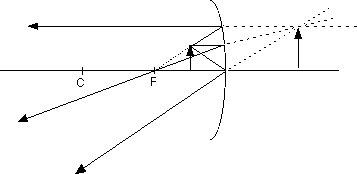
Now we are ready for the "image equation",
The focal length is one-half the radius of curvature
Your face is the object so the object distance is do = 25 cm
The negative sign means this is a
virtual image.
We can find the magnification from
![]()
The magnification is M = 2. This
positive magnification means the image is
upright. Since M > 1, the image is
enlarged.
24.7 A dentist holds a concave mirror of radius of curvature
50 mm at a distance of 20 mm from a cavity in a tooth. Where is the
image of the cavity and how large is it?
From the radius of curvature, we know the focal length,
The object distance is
Now we can calculate the image distance,
(Ray diagrams are still important. The ray diagram for this would look similar to the one for the previous problem).
We now find the magnification by
![]()
The image of the cavity is
five times the real cavity (and the image is
upright). It is also a virtual image.
24.17 A man standing 1.52 m in front of a shaving mirror
produces an inverted image 18.0 cm in front of it. How close to the
mirror should he stand if he wants to form an upright image of his
chin that is twice the actual size of his chin?
The initial information about object distance and image distance lets
us determine the focal length of the mirror --
![]()
Notice that di = + 18 cm since the image is in front of the mirror (and since it is inverted). The fact that do = 152 cm should be easy.
![]()
di = - 2 do
Essentially, we have two equations with two unknowns,
24.24 If you look at your toes while
standing in 1.0 m of water, how far below the surface will they
appear to be?
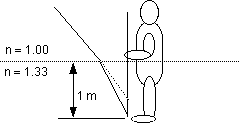
The apparent depth is given by
24.29 A light 5.0 cm tall is held 30 cm in front of a
converging lens with focal length of 24.0 cm. Locate and describe the
image.
Again, a ray diagram will be very useful.
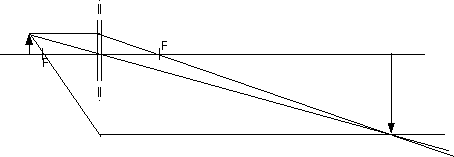
From the ray diagram we know the image is
The image distance can be approximated as about
120 cm or so.
Now we are ready to do the actual calculations,
(My estimate was unusually close!)
The positive value for the image distance means it is a real image.
![]()
The image is four times the size of the object, and inverted.
hi = (- 4)(5 cm)
hi = 20 cm
24.43 a) How far from a converging lens of focal length 60 cm
must an object be placed if the image is to be real and four times as
large as the object?
b) Repeat the calculation for a virtual image.
Knowing the magnification gives us an equation relating di
and do,
The magnification for a real image
is negative.
Now we can apply the image equation or the thin lens equation,
![]()
do = 45 cm
For the virtual image of part b), the magnification will be positive, meaning the image is also upright. Therefore,
![]()
![]()
![]()
![]()
![]()
do = (5/4) 60 cm
do = 75 cm
24.47 An astronaut in a space lab focuses a 60 mm focal length
camera lens to form a sharp image of Earth. How far must she move the
lens (and will it be toward or away from the film) in order to focus
on a fellow astronaut, 3.0 m away?
Earth is essentially infinitely far away from the lens so
do = °. We can then calculate the initial image
distance di1.
Now we calculate the image distance di2 when the object distance is do = 3.0 m = 3,000 mm,
The difference in these two is the amount by which the distance from camera lens to film plane must be changed,
24.73 An object is placed to the left of a 20 cm focal length
lens. Where is the image formed as the object is moved to the
following object distances?
do = 10 cm, 20 cm, 25 cm, 50 cm, 75 cm
This requires the same type of calculation to be done several times. In a case like this, it is better or more efficient to solve this once symbolically and then put numbers into the resulting equation.
At this point, it is easy and efficient (altho’ not at all necessary) to put this into a small spreadsheet&emdash;
|
f |
do |
di |
M |
|
( cm ) |
( cm ) |
( cm ) |
|
|
20 |
10 |
- 20.00 |
2.00 |
|
20 |
20 |
° |
|
|
20 |
25 |
100.00 |
- 4.00 |
|
20 |
50 |
33.33 |
- 0.67 |
|
20 |
75 |
27.27 |
- 0.36 |
As always, it is interesting and useful to compare these calculated results with ray diagrams.
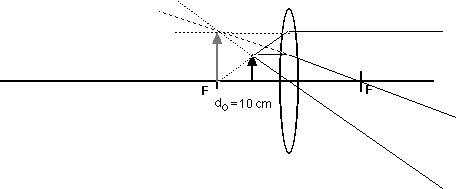
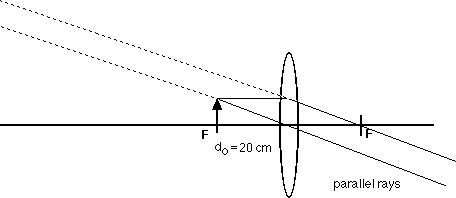





![]()
(c) Doug Davis, 2002; all rights reserved

Return to PHY 1160's Home Page